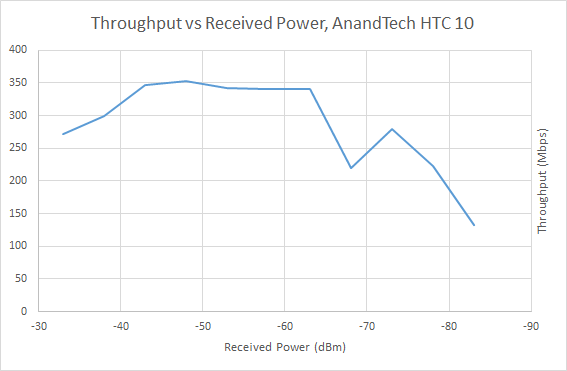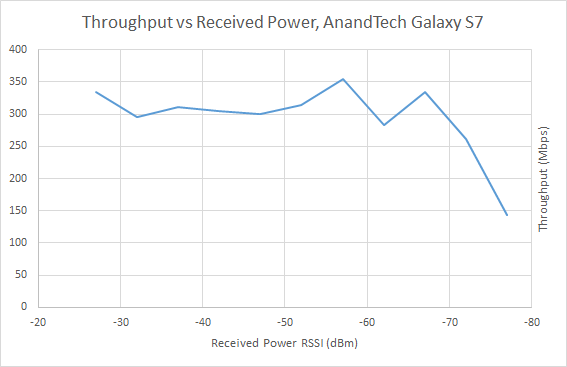The Samsung Galaxy S7 and S7 edge Review: Part 2
by Joshua Ho on July 5, 2016 8:00 AM ESTWiFi Testing with Ixia IoT
As previously discussed, RF testing has always been a major unknown to some extent because environmental factors make it extremely difficult to tell exactly what is going on with the system. I don’t think it really needs to be said but previous reviews and any controversy regarding the quality of RF has always lead to a ring of confusion and back and forth with no clear-cut answers, at least in the public domain. The Transformer Prime and Pixel C reception issues have all been cases where I’ve seen a lot of confusion over whether a problem really existed in the hardware, software, or with the end user.
Most people really don’t have any understanding of how wireless transmission works, probably because it’s not really something you can see. As far as I know, no one is capable of seeing radio waves, even at high frequencies like 60 GHz. Of course, the problem is that for quite some time our testing was also not really ideal for seeing the quality of an RF implementation. While iPerf does provide some useful data, free space testing means that we’re dealing with channel conditions that inherently cannot be controlled. As a result, the only sensible test we could do with iPerf was focus on maximum throughput in the best conditions we could provide. The only thing that this can highlight is the upper bound of efficiency for WiFi due to the carrier sense multiple access scheme in most cases, and rarely detects a whole class of problems that affect user experience on WiFi.
In order to test these things we’ve moved to using a proper testing system that is actually used by at least a few OEMs today, namely Ixia IoT. While we discussed the possibilities for testing, at this time due to the RF isolation chamber used we are limited to AP simulation only, so we can’t properly simulate clients in the channel without restricting ourselves to a single spatial stream for both the AP and client. This wouldn’t be a very useful test if set up in this manner as most devices today that we’re testing have support for two spatial streams, and many routers have three or even four spatial streams at this point.
The first set of results we can talk about that will be of interest is rate vs range. This is a fairly simple test at a conceptual level, as it simply tries to see how well a device can maintain its performance in the face of reducing signal to noise ratio for a given modulation and coding scheme. This is a good high level test of how well a device can maintain a connection as reception degrades. In this test the HTC 10 had an initial RSSI of -28 dBm while the GS7 was at -21 dBm and the iPhone 6s at -22 dBm, which allows us to calculate the path loss and determine the RSSI as a function of the transmit power.
The results of this test are interesting to say the least. Off the bat, every device had different RSSIs measured, so this meant that everything had different levels of path loss. The HTC 10 seemed to have the most path loss, while the Galaxy S7 and iPhone 6s were functionally identical. However it looks like RSSI is really an insufficient metric here because while the iPhone 6s was able to reach maximum throughput using NSS 2 MCS 8, the HTC 10 and Galaxy S7 did its best at NSS 2 MCS 4 or 5. I suspect this may be just due to placement as device positioning strongly affects MIMO as receive-side spatial correlation reduces the gains that MIMO can provide. Regardless, the HTC 10 somehow manages to beat the Galaxy S7 through much of the curve, but for some reason suffers from a reduction in throughput at higher transmit power. It's worth mentioning though that this test doesn't allow for testing of antenna gain or similar tests. Given various levels of futzing about with the device positioning in the test chamber I'm fairly confident that the Galaxy S7 is consistently better with regard to path loss, so even if it doesn't perform as well at a given RSSI it tends to have a higher RSSI than the HTC 10 by about 5 dBm which is fairly significant.
Finally, the other test that we can run at this time is the roaming latency test, which tests how well a device can hop from one access point to another as the received transmit power rises and falls. If you ever rely on WiFi to work as you walk around any building larger than a single apartment unit, you’re going to feel the effects of high roaming latency as VOIP calls or any real-time network application will either experience interruption or drop altogether if roaming is not implemented properly.

In the case of the Galaxy S7, roaming latency is honestly rather wanting. In the best case the Galaxy S7's roaming latency appears to be acceptable, but it's still significantly worse than the best we've seen so far. It seems that Samsung's algorithms have issues with edge cases as I've seen multiple instances so far where the device just can't handle roaming consistently. Despite consistent positioning and identical test setup I've seen cases where the Galaxy S7 has problems with consistent roaming. Even with the simple case of 10 dBm to -45 dBm at 3 dBm drop per second, I've encountered weirdness where the device drops from the network altogether claiming that the password given was incorrect (it wasn't) or a few successful handovers followed by getting stuck on a single access point or dropping from the network entirely. Even in the best set of trials performed I still saw 3 of 64 trials fail to roam correctly. The performance is certainly far better than something like the Google Pixel C, but Samsung should really be focusing on improving here.













266 Comments
View All Comments
Impulses - Thursday, July 7, 2016 - link
Eh... It's not like Samsung's focusing makes it a particularly great camera for shooting hardcore action (no smartphone within the current climate is gonna manage that)...So I'd actually argue that AF doesn't really take such top billing, in fact depending on what you're shooting it can be somewhat irrelevant. On a technical level it's super interesting tho.
The fact that they've got a dual pixel arrangement working at such a high level almost makes it puzzling that they haven't implemented it on a larger sensor and never tried carrying it over to their now dead camera division.
lilmoe - Thursday, July 7, 2016 - link
Yea, fanboys would have an argument like yours too... Tim Cook knows exactly how important the autofocus system is.Impulses - Thursday, July 7, 2016 - link
Not sure what brand I'm supposed to be a fan boy of, heh... I've never bought neither a Samsung nor an Apple phone, and probably never will unless Samsung drastically changes their software strategy or GPe comes back.My point was coming from a snobbish "I wouldn't use a phone for THAT" (vs a dedicated camera) pov. ;)
lilmoe - Friday, July 8, 2016 - link
Snob... Fanboy... All the same.Case in point, you don't need to be shooting fast action to realize the benefits of great autofocus. If you're taking pictures of your kids or buddies on a trip, then it means either getting the shot or not. If it's blurry, then all that snobby pixel peeping won't help you much.
FourEyedGeek - Saturday, July 9, 2016 - link
Judgemental dickwad.johnnohj - Tuesday, July 5, 2016 - link
Exactly, how much better was the performance on the browser benchmarks with the Snapdragon browser or the Samsung stock browser? Why didn't you include them?ikjadoon - Tuesday, July 5, 2016 - link
Snapdragon Browsers are great; I use one on my OPO and it's a huge boost in scrolling, page loading, and overall speed. Using Chrome vs Tugabrowser on my OPO is like using Firefox vs Chrome on my PC. It's not even close.But, they don't ship with the device. It's a 3rd-party app you have to download onto your phone.
--
Samsung Browser...yeah, no idea why they didn't include that. That should've been in there. They test Safari on iPhones, why not test SB on Samsung phones?
kurahk7 - Tuesday, July 5, 2016 - link
Samsung sent everyone Verizon versions which until a couple months ago didn't support the Samsung browser. But since this review was so late, they should have included it and talked about the functionality of it.JoshHo - Tuesday, July 5, 2016 - link
I tried shortly after the Samsung stock browser was made available and a number of our benchmarks wouldn't complete or performed worse than Chrome so I didn't include those results.asfletch - Tuesday, July 5, 2016 - link
Hmm that is odd. On my Note 4 Exynos, the Samsung Browser runs Jetstream, Vellamo, Kraken et al just fine, and way faster than Chrome (esp now Adblock Plus is officially available for it - so good). Feels far faster in use too, as mentioned in this review. Maybe it's the SD820 - could Andrei test the 8890 version with Samsung Browser please?